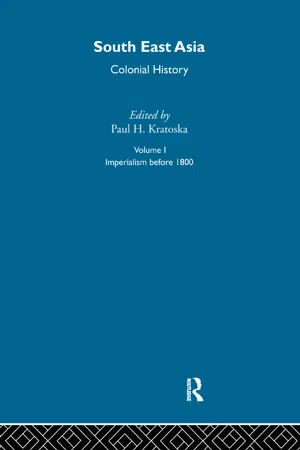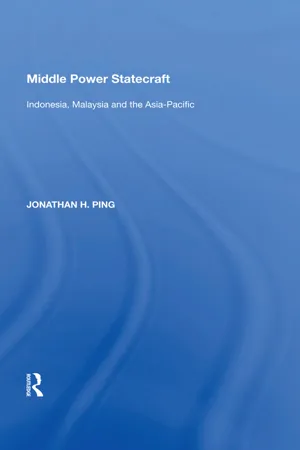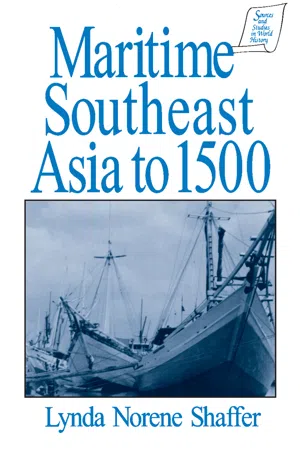History
Srivijaya Empire
Srivijaya Empire was a maritime and commercial kingdom that flourished in Southeast Asia from the 7th to 13th centuries. It was a powerful center for trade, controlling the strategic Malacca and Sunda straits. Srivijaya's influence extended across the Malay Peninsula, Sumatra, Java, and parts of Borneo, and it played a significant role in spreading Indian culture and Buddhism in the region.
Written by Perlego with AI-assistance
Related key terms
3 Key excerpts on "Srivijaya Empire"
- eBook - ePub
- Paul Kratoska(Author)
- 2022(Publication Date)
- Routledge(Publisher)
2 sees a vital connection between Chinese maritime policy and the integrity of the Srivijayan empire. For a long time after the opening of the sea trade of China, the Chinese preferred to stay at home and depended upon Arab and Persian merchants for the import and export of goods. From seventh century onwards, Malay traders and shippers of the Srivijayan empire began doing a thriving business with China along with west Asians.The sea trade of China was controlled by what is known as the Tribute System. From the Chinese point of view, the foreign traders were looked upon as bearers of tribute to the Chinese emperor from whom they received gifts in return. The geographical location of Srivijaya enabled it to play a very crucial role in the final phase of the carrying trade to China. Palembang, the capital of Srivijaya, was the last stop to China for traders coming from the west. When the wind was right a ship usually took about twenty days to reach Canton from Palembang. It seems that between the seventh and thirteenth century, the intermediate trade between western Indonesia and south China was dominated by Srivijaya.The Chinese themselves did not show much interest in sailing out to the Malacca Strait region before the ninth century. With the greater use of the compass in the following centuries the sea-going vessels of China began to venture out in the Indian Ocean area. In the twelfth century the Chinese ships were trading with Quilon in south India. As the Chinese themselves made frequent voyages through the Malacca Strait in their own ships the intermediary role of Srivijaya as a carrier of China trade became increasingly superfluous. Consequently the Srivijayan empire began to break up in the thirteenth century. The core of the kingdom of Srivijaya, however, survived till the last quarter of the fourteenth century when the unpredictable shifts in the maritime policy of the Mings in the reign of Tai-tsu (1368–1398) brought about its final disintegration. - eBook - ePub
Middle Power Statecraft
Indonesia, Malaysia and the Asia-Pacific
- Jonathan H. Ping(Author)
- 2017(Publication Date)
- Routledge(Publisher)
In Indonesia, hybridisation of Hindu-Buddhism created new forms of statecraft and PP that gave rise to two major empires. From the seventh century the Kingdom of Srivijaya in Southern Sumatra, principally on the Palembang River, dominated an empire of fourteen or fifteen smaller kingdoms, which stretched from Kedah on the Malay Peninsula down into present-day Indonesian Sumatra, through Java and on to Bali (Coedes 1918, 1968 & 1992; Kingsbury 1998, 23; Abu-Lughod 1989, 304). Indigenous kings who had adopted the hybridised Hindu-Buddhist model controlled all of these kingdoms.Many authors, including Wang (1958), Coedes (1918, 1968 & 1992), Nilakanta Sastri (1949) and Hall (1985), accept the existence of Srivijaya, which was first proposed by Coedes in 1918 as a result of extensive epigraphic study. However, Spencer (1983) and Abu-Lughod (1989) believe it to be a ‘front’ or a ‘hoax’ perpetrated for the purpose of gaining access to China via Tribute Trade. Abu-Lughod argues that: ‘It seems as if Srivijaya’s real role was to “market” south Indian goods, as well as her own and those from the Middle East’ (1989, 304). The thesis follows that the rise and fall of Srivijaya and other archipelago states and empires was the result of external policy changes in hegemonic China in regard to the interdiction of Chinese ports to nonsubservient trading partners. In Srivijaya’s case the barring of Indian and Arab ships from Chinese ports during the Song Dynasty (960–1279) allowed Srivijaya to act as a middleman. The removal of the interdiction by the Yuan Dynasty (1279–1368) saw the collapse of Srivijaya. The Ming Dynasty’s (1368–1644) policy of barring foreign vessels gave middleman status back to the archipelago and the brief return of Chinese adventurism with the passage of Admiral Yin Ching in 1403 and the subsequent voyages of Admiral Cheng Ho (1408–1431) aided the rise of Malacca. - eBook - ePub
- Lynda Norene Shaffer(Author)
- 2015(Publication Date)
- Routledge(Publisher)
K. Hall, 1985a : 83).Srivijaya and the Javanese Sailendras
Srivijaya’s success hinged on its location on an international trade route, its fine harbor, its silt-laden and navigable river, and the political and economic talents of its rulers, who subdued the pirates and promoted the region’s trade. But there was yet another important element in its success, a close relationship with their coreligionists, the Buddhist Sailendras, a royal lineage located in Central Java, well outside Srivijaya’s realm.Although Srivijaya’s agricultural resources were superior to those of any other port in the straits area, it is unlikely that its production was equal to the task of provisioning the ships and feeding international travelers, especially after the dramatic increase in traffic that occurred in the eighth century. Central Java was and is, however, the most productive agricultural region in the island realm. Srivijaya’s close relationship with the Sailendras may well have been based on a mutually beneficial exchange relationship that ensured Srivijaya’s access to some of Central Java’s crops. Thus, any picture of Srivijaya would be incomplete without a consideration of Central Java’s temple realm and Srivijaya’s relationship to it.1. Bas-relief carving of a sailing craft at Borobudur in Central Java, late eighth century. The ships carved on the Borobudur monument testify to the early development of Malay maritime technology. (Courtesy, H. Parker James.)2. A Jakarta harbor today. Although most of Indonesia’s cargo now moves on modern ships, sailing craft of traditional design are still in use. Dock workers were unloading lumber from the island of Kalimantan when this photo was taken. (Courtesy, Brady Hughes.)3. A Jakarta harbor today. A close look at the bows of sailing ships still in use reveals some similarities to the ships carved on the walls of Borobudur. (Courtesy, Brady Hughes.)4.
Index pages curate the most relevant extracts from our library of academic textbooks. They’ve been created using an in-house natural language model (NLM), each adding context and meaning to key research topics.


